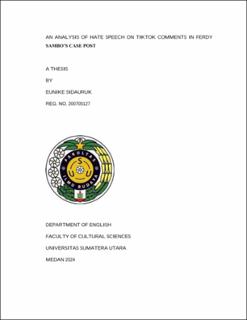| dc.description.abstract | This study aims to identify hate speech in the comments column from several TikTok accounts on posts about the Ferdy Sambo case using a pragmatic approach. This study used a descriptive qualitative method. The information in this research was taken from comments from several TikTok accounts that were posted regarding the Ferdy Sambo case which went viral in 2022. There were 45 haters' comments related to the type of hate speech and the intention of the hate speech to Ferdy Sambo in TikTok. The results found 5 types of hate speech related to netizen comments, namely as follows: referring to 20 class types of hate speech, 17 behavior, 4 religion, 3 physical, and 1 sexual orientation. Class is the type of hate speech that is the most dominant in netizen comments regarding the Ferdy Sambo case. On the other hand, based on the intention of the hate speech, it was found that there were 4, namely as follows: 25 insulting, 18 insinuating, 1 mocking, and 1 blaming. The most dominant intention of hate speech based on netizen comments is insulting. | en_US |


